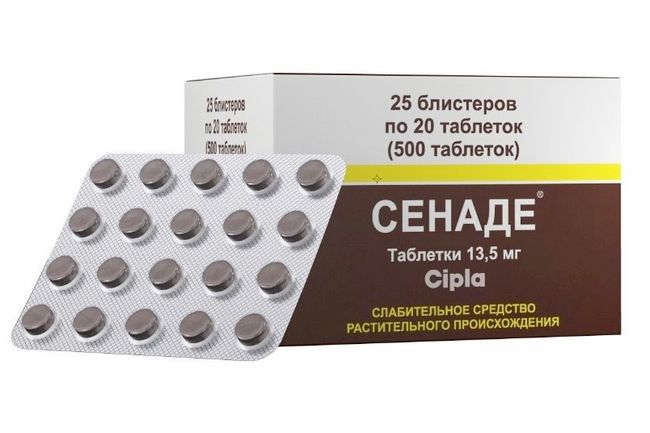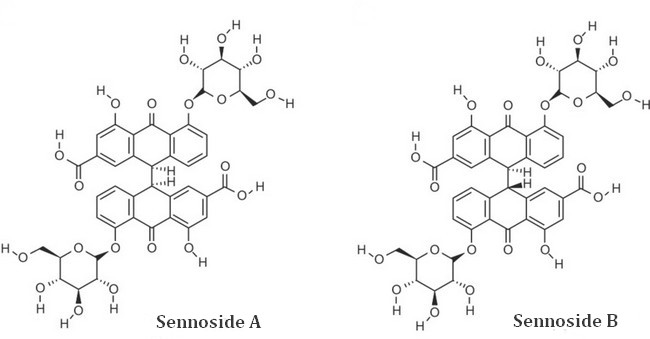Laxatives were historically used to lose weight because these substances were believed to help instantly evacuate the consumed fats and carbohydrates, preventing their retention in the body or deposition in the form of fat. However, it’s not that simple. The kilograms don’t just disappear, but the trouble with the stomach and stool begins.
To avoid this, one needs to know how to use them in such cases and also carefully approach the dosage and the duration of the course. For example, they often recommend Senade for weight loss, praising it for its mild laxative effect and the minimum of side effects. Should you trust such recommendations?
Brief Overview of the Drug

Trade name: Senade. Latin name: Senade.
ATX code: A06AB06 — laxatives on the basis of senna glycosides, which affect the gastrointestinal tract and metabolism.
Main acting component: senna glycosides A and B.
Chemical formula — C42H28O20.
Structural formula:

Form: round, flat, with beveled edges, brown or dark brown tablets with alternating dark impregnations. On one side, the name “CIPLA” is extruded, on the other side, there is a dividing line. Each tablet contains 13.5 mg of the main acting component.
Packaging:
- 2 blisters of 20 tablets each in a cardboard box (40 pcs. in total);
- 3 blisters of 20 tablets each in a cardboard box (60 pcs.);
- 25 blisters of 20 tablets each in a cardboard box (500 pcs.)
Manufacturer: the Indian pharmaceutical company Cipla Ltd.
Purpose: laxative.
Dosage form: for oral administration.
It is absorbed through the intestinal mucosa in a small amount (only 5%). In the large intestine, sennoside is hydrolyzed under the influence of digestive enzymes with the formation of free anthraquinones. The predominant part is excreted with feces, and a smaller part is excreted by kidneys with urine.
Time of action: depending on individual features of the body, approximately 8 hours, maximum — 10.
Composition
The main acting component is calcium salts of senna glycosides A and B, isolated from the leaves of Alexandria senna (cassia africana, cassia oxyphylla, senna alexandrina). Content — 13.5 mg.
The composition also includes excipients:
- starch — 43.56 mg;
- MCC – 15 mg;
- lactose — 23.07 mg;
- methylparaben (preservative E218) — 0.04 mg;
- magnesium stearate as a binder and structuring agent — 0.93 mg;
- carboxymethylcellulose (thickener E468) — 2 mg;
- talc — 11.13 mg;
- sodium lauryl sulfate (surfactant) — 0.93 mg.
Excipients do not have a significant effect on the gastrointestinal tract and other organs since they are contained in a minimum number.
Mechanism of Action
The mechanism of the laxative effect of Senade is simple for understanding (scheme):
Sennosides get into the large intestine → Begin to actively influence sensitive mechanoreceptors of the mucous membrane → Peristalsis increases (the strength, amplitude, and duration of the intestinal wall contractions) → Fecal masses start moving → Due to the increased contractions of the muscular frame, the intestine tries to push them out faster → A person experiences an irresistible urge to defecate → Defecation
The consistency of feces does not change. They come out as usual, in a normal amount. This does not harm in any way the process of digestion. Assimilation of nutrients in the gastrointestinal tract and their absorption into the blood don’t get hindered, that is, they don’t instantly exit the body. Therefore, the drug is considered mild.
Increased peristalsis pushes out not only feces but also everything that has accumulated on the intestinal walls. As a result, the drug also has a cleansing effect.
Knowing the principle of action of Senade, it is possible to use its laxative properties for weight loss.
Myth debunking. Do not flatter yourself with the fact that Senade also has diuretic properties. It is exclusively a laxative agent — and nothing more. It does not affect the level of water-salt balance; excess fluid is not excreted from the tissues, and you won’t experience an effect of getting rid of edema after taking it.
Indications for Use

If you have decided to lose weight in such an unconventional way, you need to know what the remedy can help with and in which situations it is prescribed.
Official indications for use of Senade according to the instructions:
- problems with defecation, in particular — constipation;
- weak peristalsis and atony of the large intestine;
- discomfort in the abdomen;
- hemorrhoids;
- proctitis (inflammation of the rectum or sigmoid colon), paraproctitis (chronic form);
- anal fissures of various etiologies;
- for preparation to ultrasound, radiography, endoscopic examination of the abdominal organs when cleansing the intestines is required.
It is not effective for all constipation. It is prescribed only when difficulties with stool are caused by such factors (in addition to weak peristalsis):
- low mobility;
- low physical activity (or its complete absence);
- stressful situations;
- insufficient fluid intake;
- change of climate;
- imbalanced diet (predominance of binding food in the diet: pastries, rice, pasta, potatoes);
- overweight.
Knowing what the remedy is intended for, it is easier to make a decision about the feasibility of its application.
Benefit in Weight Loss
The drug is often used for weight loss. Is it justified? There is only one indication for using it for losing extra pounds — constipation caused by low mobility and overweight. If there is no such problem, it is undesirable to take the drug for weight loss.
Nevertheless, Senade has some effect as an auxiliary means for losing weight, due to:
- removal of accumulated stool masses from the large intestine;
- intestinal cleansing from other slagging.
What one should not expect from Senade for weight loss:
- the drug does not accelerate or improve digestion;
- does not slow down the absorption of food (all eaten carbohydrates and fats will be digested, get into the blood, increase blood glucose levels, and deposit on the hips, as before), and are not instantly excreted in an unprocessed form;
- does not initiate lipolysis, does not accelerate fat burning;
- does not remove excess fluid, does not relieve swelling.
How to use diet pills for good:
- take 1-2 days before the start of the diet for cleansing the intestines;



